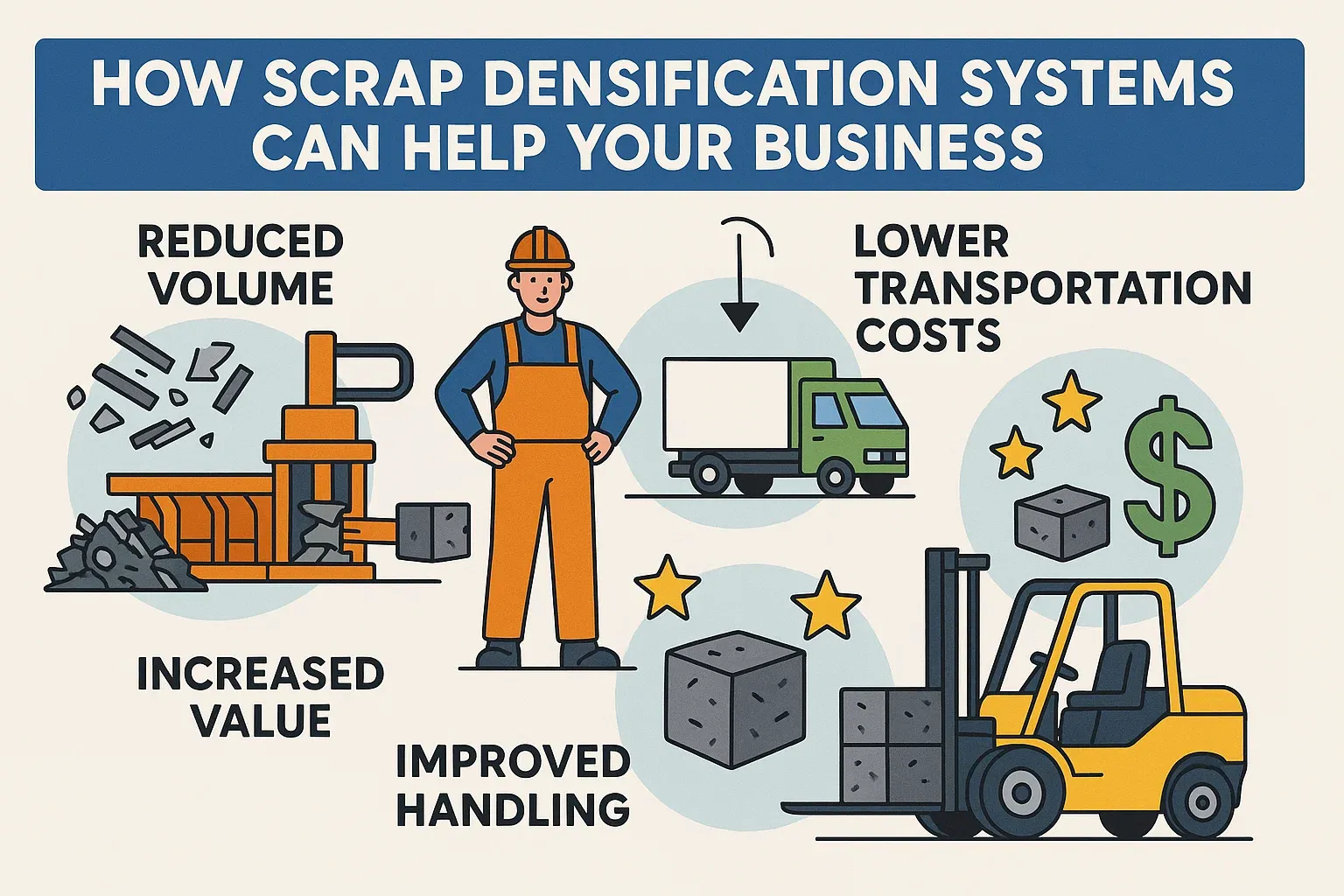Sistemas de densificação de sucata desempenham um papel vital na melhoria da eficiência operacional e da lucratividade nos setores de reciclagem e manufatura. Para empresas que lidam com quantidades significativas de materiais descartados, como plásticos, espuma, aparas de metal ou resíduos de papel, implementar um sistema de densificação pode ser transformador.
O que é um sistema de densificação de sucata?
Um sistema de densificação de sucata é um equipamento industrial projetado para compactar ou comprimir materiais de sucata em formas mais densas, normalmente pellets, briquetes ou blocos. Isso reduz o volume, simplifica o manuseio e aumenta significativamente a eficiência dos processos subsequentes de reciclagem ou descarte.
Principais benefícios dos sistemas de densificação de sucata
Eficiência de espaço aprimorada
Uma das vantagens mais imediatas da densificação é a redução substancial do espaço de armazenamento necessário. Materiais soltos e de sucata são volumosos e difíceis de armazenar. Ao compactar esses materiais, as empresas podem recuperar espaço de trabalho valioso, otimizar a logística de armazenamento e reduzir o congestionamento nos armazéns.
Economia de custos em transporte
Os custos de transporte podem impactar significativamente a lucratividade. Sistemas de densificação comprimem a sucata em formas mais densas, reduzindo drasticamente o volume de transporte e permitindo cargas mais pesadas e econômicas. Isso significa menos viagens, menores custos de combustível e menor impacto ambiental.
Melhoria no manuseio de materiais
Materiais compactados, como briquetes ou pellets, são mais fáceis e seguros de manusear em comparação com sucata solta. Eles representam menos riscos aos funcionários, simplificam os processos de manuseio mecânico e aumentam a segurança operacional geral.
Aumento da receita de reciclagem
A sucata densificada normalmente alcança valores de mercado mais elevados do que o material a granel devido à sua maior densidade e facilidade de manuseio para recicladores. As empresas podem negociar melhores preços e aumentar suas margens de lucro com a venda de materiais de sucata.
Sustentabilidade Ambiental
A implementação de um sistema de densificação de sucata aprimora as iniciativas de sustentabilidade, minimizando o volume de resíduos, reduzindo o uso de aterros sanitários e diminuindo as emissões relacionadas ao transporte. Empresas comprometidas com iniciativas sustentáveis podem se beneficiar significativamente da integração da densificação em suas operações de reciclagem.
Fluxo de trabalho de um sistema de densificação típico
Aqui está um fluxo de trabalho simplificado:
- Alimentação de material: Materiais soltos são alimentados na unidade de densificação por meio de transportadores ou entrada manual.
- Compactação: Os materiais são comprimidos sob alta pressão.
- Resfriamento (se necessário): Alguns sistemas podem incluir estágios de resfriamento para solidificar materiais rapidamente.
- Saída: Briquetes, pellets ou blocos comprimidos saem do sistema para armazenamento ou transporte.
Escolhendo o sistema de densificação de sucata correto
Selecionar o sistema certo envolve avaliar as necessidades específicas do seu negócio:
- Tipo de material: Os sistemas são projetados de forma diferente para plásticos, metais ou espuma. Escolha equipamentos otimizados para o seu tipo principal de sucata.
- Requisitos de capacidade: Ajuste a produtividade do equipamento à sua produção diária de sucata para manter a eficiência.
- Facilidade de integração: Considere sistemas compatíveis com linhas de reciclagem ou fabricação existentes para interrupção mínima.
- Custos operacionais: Avalie o consumo de energia, os requisitos de manutenção e o custo total de propriedade.
Comparação de desempenho: sucata solta vs. sucata densificada
| Fator | Sucata solta | Sucata Densificada |
|---|---|---|
| Espaço de armazenamento | Alto | Baixo |
| Custo de transporte | Alto | Baixo |
| Lidando com a dificuldade | Alto | Baixo |
| Valor de mercado | Baixo a moderado | Alto |
| Impacto Ambiental | Mais alto | Mais baixo |
Conclusão
Investir em um sistema de densificação de sucata proporciona benefícios operacionais, econômicos e ambientais tangíveis. Para empresas que lidam com quantidades consideráveis de sucata, essa tecnologia representa um passo estratégico rumo a maior eficiência, sustentabilidade e lucratividade.



